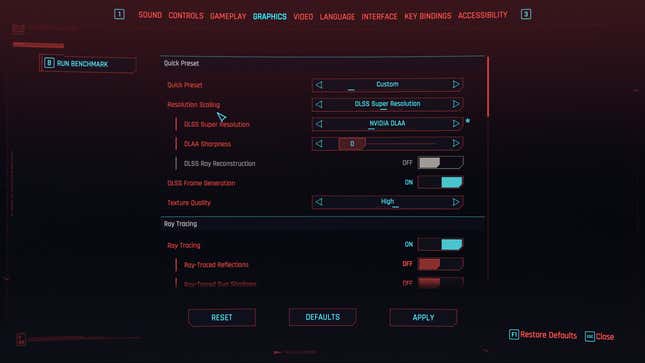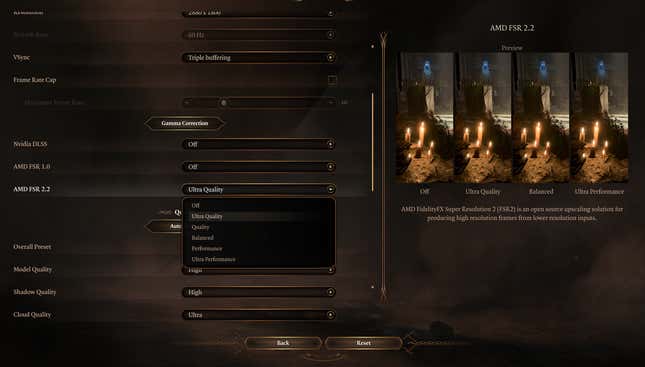
How to Get Better Framerates for PC Gaming
Many of us grew up in the age when playing PC games at their highest settings required a hefty rig. For laptop users who weren’t willing to shell out thousands of dollars for a gaming-capable portable device, it always felt like you were being lapped by those with the space and deep pockets to afford the latest CPU and GPU. However, nowadays, even modest gaming PCs and laptops can play a fair number of recent titles. AI upscaling tech from AMD, Nvidia, and Intel is a big reason for this.
Gaming on PC is too expensive. That’s the long and short of it. A GPU considered “mid-range” by today’s standards might run well above $300. Still, we’ve found that thanks to modern super scaling systems like FSR, DLSS, and XeSS, you can push a lower-budget PC to take on titles that are usually out of your reach. For those who might want to play games at 4K with less-than-ideal hardware, these AI-based options manage to approximate what it’s like to see a demanding game like Cyberpunk 2077 at its peak or play multiplayer games like The Finals without feeling like you’re being limited just because you don’t have a PC that can hit 60 FPS when too much is happening on-screen.
At the same time, super scaling tech is confusing, especially as different games might support some or all the features of Nvidia’s, Intel’s, and AMD’s tech. Soon enough, Microsoft may make Windows itself the glue to hold all the disparate super-scaling tech together. This new API called “DirectSR” will make it much easier for developers to get their games to support all the current top-of-the-line upscaling tech. With the recently announced toolset, developers can do one singular code path to invest in that AI upscaling. But expect far more PC titles to support AI frames shortly.
So it’s only good news from here on out. The few rough edges with AI-based upscaling have been sanded down over the years, and now there are very few reasons not to apply some level of DLSS or FSR in supporting games unless you’re using the tippy top-of-the-line hardware.
The problem is, as different GPU makers sponsor some games, you might find a title that will support Nvidia’s DLSS and Intel’s XeSS but none of AMD’s super-resolution tech. Despite the developers’ statement that it is easy to move between the three super sampling APIs, Then there are titles like the Resident Evil 4 remake that only support AMD’s FSR and Apple’s MetalFX (after Capcom re-released its game on all Apple’s platforms, including Mac and iOS). We had to wait months before Bethesda released DLSS support in Starfield as, at the start, it only supported FSR. It’s rather annoying how your ability to get good framerates in your game depends on the whims of sponsorship deals. Still, perhaps with Microsoft’s upcoming API, we might see a lot more cross-pollination.
You’ll need to find which games support which upscaling tech, but the setting should appear in the graphics options for most game menus. The tech is moving so fast that some new titles will appear with older versions of the super-resolution, so don’t be surprised if the latest release doesn’t have all the bells and whistles you might want.
What are Nvidia’s DLSS, DLAA, and Altered Ray Tracing?

Nvidia’s AI upscaling tech remains the most prolific among supported games, and we’ve often found it to be the most capable of boosting framerates without directly sacrificing image quality.
DLSS stands for deep learning supersampling. As the name suggests, it’s a constantly evolving software suite that takes a frame from a game running at a lower resolution and then superimposes the details of the game running at a higher resolution. In addition, There’s also DLSS Frame Generation, which creates artificial frames to increase framerates further. That latter process is only available on the RTX 40-series generation of Nvidia’s GPUs, and of course, you won’t find the option in every game, even recent titles that support DLSS. You also won’t see any support for non-Nvidia graphics cards.
Most recent Nvidia cards support DLSS to some degree, though you won’t find the tensor cores needed for these graphics capabilities before the RTX 20 series. If you want access to all the latest DLSS 3.5 offers, you must have an RTX 40-series card. If that puts a damper on your high expectations, know that even older versions of Nvidia’s super sampling tech will grant improved framerates upwards of 70%. Nvidia has said recent implementations of DLSS can give two to three times as many frames, and based on our own experiences, that isn’t far off the mark.
The best aspect of the recent updates to DLSS is the ability to choose different modes. These usually range from “performance” through “quality,” letting the player decide to emphasize how nice a game looks or framerates. Better PCs would probably opt for “quality” DLSS, but older or less-capable computers can try to stress framerates while bumping up resolution or other in-game settings.
On the flip side, there’s also the DLSS Super Resolution, which reconstructs a higher quality resolution up to 4K from a lower resolution. You might also spot options for DLAA or deep learning anti-aliasing in some games. This feature is supposed to smooth the jagged edges of in-game objects. However, compared to TAA—or temporal anti-aliasing—DLAA uses deep learning algorithms similar to DLSS’s. DLAA has been around for a few years, but only a few more recent games, like Baldur’s Gate III and Marvel’s Spider-Man, currently support the latest version.
There’s also the company’s altered ray tracing called ray reconstruction. While it might seem like a confusing mess of technical terms, ray tracing in games essentially tries to replicate the effect of light hitting different objects. It’s often too taxing for any computer to model many other light rays, so a computer will often only model a few rays, then denoising all the missing light rays. The DLSS ray reconstruction effectively replaces the need for computers to handle computationally intensive denoising processes with an AI algorithm that smooths out the areas between sampled rays. In even simpler layperson terms, ray tracing looks just as nice without putting the processing burden on your PC.
There’s a growing list of more than 300 titles that support the super scaling tech, and more are coming in 2024. Nvidia is the most proactive of the three companies releasing support for DLSS in games. The company is consistently unveiling new titles that support DLSS, such as the PC release of Horizon: Forbidden West. Other games are still working on DLSS 2, like Sons of the Forest or Mortal Kombat One.
Now, are there problems with DLSS? Potentially, especially depending on the game. Prior forms of Nvidia’s super sampling could blur text shown in the game during periods of action. Later versions of the software have fixed this problem to some extent. Earlier versions of the sampling software would also blur the in-game image to some extent, and even the more modern versions can result in slight flickering or blurring of fast-moving or small in-game objects thanks to generated frames. Thankfully, games like Cyberpunk 2077 let you fine-tune DLSS until you reach a perfect equilibrium of performance and looks.
What is Intel’s XeSS?

Did you like all these technical acronyms? Well, Intel’s version of AI sampling is an acronym sandwich. XeSS stands for Xe Super Sampling. The Xe relates to Intel’s form of discrete graphics used on its CPUs. It’s a similar deep-learning sampling tech that synthesizes frames at a higher resolution, and Intel promises you can get performance boosts twice on most supporting titles.
So straight up, XeSS is a bit more new than Nvidia’s super sampling tech and isn’t as customizable or detailed. However, the stated 2X framerates boost is no lie. It’s capable of taking a game running at 1080p resolution and making it look like it’s running at 4K, all while taking the framerates of the lower resolution. XeSS also includes a built-in AI anti-aliasing.
DLSS is limited to RTX GPUs, but Intel’s super sampling is available across Arc-based graphics processors and chips that support Intel Xe integrated graphics. It’s also available in some form to all AMD RX 6000 and 7000 series GPUS, along with all Nvidia GTX 10-series or newer. That’s practically the entire gamut of modern graphics processors in a PC that supports Shader Model 6.4.
The major limiting factor is the number of games that support XeSS. Intel vastly expanded the library last year, but it still pales compared to DLSS. Last August, Intel declared that more than 70 games supported Intel’s AI upscaler. However, now, according to SteamDB, there are around 100 titles that facilitate XeSS, ignoring any betas or demos.
What is AMD’s FSR?

AMD’s FidelityFX Super Resolution, or FSR, should be a common sight for PC gamers as it’s been worked on since 2019. Other than DLSS, it’s the most common upscaling tech available, and it’s been updated several times in recent years. The last big one was the move to FSR 3, which included new frame generation software that—like DLSS—will generate artificial frames between normal frames to boost performance. FSR 3 also had new “Native Anti-Aliasing” that sharpens images without upscaling.
The FSR system is also an AI upscaler under the “temporal upscaling” umbrella. AMD has boasted that some games can receive about a 3X framerate boost with FSR 3 and its AI-generated frames, though with NAA, you might only get twice as many frames with the super-resolution by itself.
In games running the latest version of FSR, you’ll often see several options to modify the super-resolution tech. These include NAA and frame generation options and modifying in-game models’ detail and texture fidelity. The more you push those options, the less increased performance you can expect.
AMD said last year that FSR 3 would be making its way to all DirectX11 and 12 titles, including those on consoles, though for now, you’ll find all the support has gone to PC. There are well over 200 games currently or will support AMD’s super-resolution tech, though varying levels. Some are restricted to earlier versions of FSR, while others may only have some effects options in the greater FidelityFX family. Some support FSR 2 or 2.1, while a growing list supports FSR 3.
A few games support AMD’s scaling tech, though they are all across a wide range of visual quality tricks. The AI upscaling “Super Resolution” is the most applicable for boosting framerates in-game without minimizing performance.
Which AI Upscaler Should I Use
Now, which one should you use? Well, it’s probably the one your game or hardware currently supports. All these upscale do the job at least moderately well, especially if your main hope is to increase framerates on old or subpar hardware. You might have to fiddle with the few options available before getting a picture quality that’s good enough for you and your hardware.
But games supporting two or all three upscale might be a bit more complicated. Currently, XeSS is the newest kid on the block, and while it has wide support across hardware, it still has the fewest options available.
That leaves DLSS and FSR. For now, DLSS has a slight edge regarding picture quality and performance optimization across supported titles. However, since developers need help from Nvidia to get DLSS going, and since it’s restricted to select varieties of GPUs, it’s still too closed a system to be accessible to all PC gamers. It’s up to developers to decide how they implement all this upscaling tech into their titles, and in the end, some games might do better with one form of upscaling over another.
Our best advice for any frame hunters out there is to experiment, twisting the knobs on settings until they get something they like. These upscaling systems are constantly being updated, and we expect to see even more improvements later this year. The most important thing to remember is that just because your system might not be the pinnacle of current hardware doesn’t mean you can’t enjoy some of the latest games on high settings, even if they’re “fake frames.”